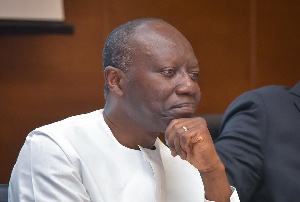 Ken Ofori-Atta, Finance Minister
Ken Ofori-Atta, Finance Minister
The financial health of Ghana’s external sector is better than it has been since the turn of this decade, the latest data from the Bank of Ghana has revealed. While Ghana’s merchandise trade surplus, which began during the last quarter of 2016, has reached new heights, this has now been joined by a current account surplus for the first time this decade and a capital and financial account surplus which by mid- 2019 was more than four times what it was a year previously. In turn this has given the country, by mid 2019 an overall balance of payments surplus more than three times its mid -2018 level, gross international reserves that are still close to record high levels despite having fallen from the all-time peak achieved in March, and consequent import cover for 4.3 months of imports, well above the 3.5 months target which is also regarded as the international standard.
Ghana has recorded a merchandise trade surplus of US$1,936.2 million for the first half of 2019, which is 54 percent bigger than the US$1,257.5 million generated during the corresponding period of last year. While total exports only grew marginally from US$7857.6 million to US$7,994.8 million – export revenue growth for gold (US$2,990.6 million), cocoa (US$1347.5 million) and oil (US$2248.0 million) was more or less flat during the first half of 2019 – both oil and non-oil imports reduced considerably. Non oil imports fell to US$4,915.0 million for the first six months of this year, down 7.1 percent from US$5,290.9 million last year, curtailed by the cedi’s 8.23 percent depreciation against the dollar since the beginning of this year which has made imported items less cost competitive against locally produced alternatives. Similarly, oil imports fell by 12.6 percent to US$1,143.6 million, down from US$1,309.1 million last year, largely as a result of the continuing substitution of imported light crude with locally produced gas, for power generation.
Combined, these enabled an 8.2 percent reduction in Ghana’s overall import bill for the first half of 2019.
The resultant trade surplus, a long term high for the Ghanaian economy has enabled the country finally achieve a long-standing objective: a current account surplus. Although marginal at US$39.1 million for the first half of 2019, it represents a performance triumph; even after narrowing the current account deficit every year for over half a decade, it still stood at US$409.3 million for the first six months of 2018.
Ghana’s US$3 billion Eurobond issuance in March this year – the country’s largest to date – generated similar improvements in the capital and financial account balance, which moved from a US$365.5 million surplus for the first half of 2018 to a US$1,681.1 million surplus for the first half of 2019.
The combination of the reversal of the customary current account deficit into a surplus and the Eurobond – driven major increase in the capital and financial account left Ghana with gross international reserves of US$8,581.2 million by the end of June this year, up significantly from the US$7,294.1 million recorded a year earlier, although down somewhat from the peak of US$9959.6 million reached in March immediately following that Eurobond issuance.. Added to this was the US$977.4 million in the country’s petroleum & stabilization account.
Consequently by the end of last month Ghana had 4.3 months import cover, up from 3.9 months cover a year earlier.
All this points towards stability of the cedi over the coming months. Indeed, the Ghanaian currency has actually appreciated marginally against the dollar during the first three weeks of July, by 0.12 percent, bringing the total depreciation since the beginning of the year down to 8.35 percent.
Importantly global market prices for all three major Ghanaian export commodities have firmed up over the one year period since June 2018, by 9.3 percent for cocoa, 8.7 percent for gold and 9.3 percent for crude oil.